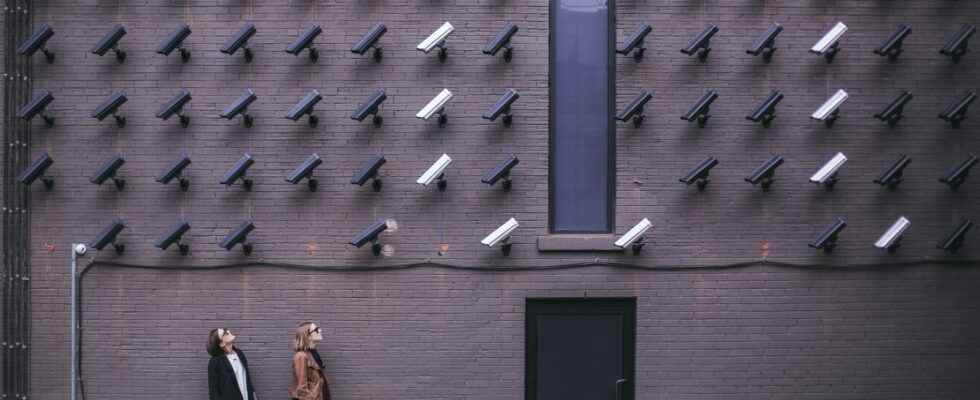The National Commission for Computing and Liberties (CNIL) warns against the use of augmented cameras which are increasingly used to monitor public space, pointing out the risk to the privacy of citizens.
Video surveillance has been part of our daily lives for a long time now. And if video surveillance systems initially relied on analog devices (cameras, video recorders, etc.) and human operators, they are increasingly using automated digital technologies, which are more efficient but also more worrying. Thus, July 19, 2022, the National Commission for Computing and Liberties (the famous CNIL) published a statement in which she warns of the risks associated with the massive deployment of so-called “augmented” cameras in public spaces, a subject that raises many questions about respect for the privacy of citizens.
Also called “smart” cameras, “augmented” cameras are surveillance cameras associated with software and artificial intelligence capable of analyzing captured images in real time. Increasingly used in various contexts, they can detect all kinds of “abnormalities” or “suspicious” behavior, but also lead to abuses that jeopardize individual freedoms. And this is what leads the CNIL to sound the alarm today.
Augmented cameras: artificial intelligence at the service of video surveillance
Since 2017 already, the National Commission for Computing and Liberties has called for vigilance regarding developments in video surveillance – or “video protection” – tools, which do not always respect the legal framework. This time, the “gendarme” of digital freedoms reveals his position on the conditions for the deployment of “augmented” video devices in places open to the public, adopting ethical, technical and legal points of view. According to her, smart cameras “represent new privacy risks“. That is why it is absolutely necessary to create “a very clear legal framework” as to the use of these tools, with “regulatory or legislative texts which authorize the use of these cameras in the public space”.
New types of cameras equipped with artificial intelligence software are developing. The CNIL distinguishes between two types of use. The first is intended for purely statistical use, which does not pose a problem. “When “augmented” cameras are used to produce statistics, consisting of anonymous data and not intended to be immediately operational, they can already be deployed, without specific supervision.“, she explains in a other report. “This would be, for example, the case of a device making it possible to calculate the crowds in the metro to display to travelers the least filled trains to which to go.“This technology was used in particular on May 29, 2021 during a Indochina test concert, in order to demonstrate the absence of contamination by the Covid-19 of the spectators. Smart cameras were used to analyze the rate of people using the mask – worn correctly, incorrectly worn or absent. So no worries.
The problem arises with regard to the use of biometric cameras, which allow an automatic analysis of the behavior of passers-by. This is particularly the case with facial recognition, which matches a human face to a digital image using scans and CCTV cameras – and which has already been adopted by eleven European Union countries, particularly in a judicial context . These augmented cameras can, for example, identify suspicious behavior, violations, abandoned luggage or even the abnormally long presence of a person in a specific location. They are multiplying in the municipalities, as in the city center of Lunel, which is equipped with three cameras equipped with loudspeakers, which apostrophize people who do not pick up dog droppings or deposit wild garbage. These devices involve the processing of sensitive data, which is in principle prohibited by the General Data Protection Regulation (GDPR) and the Data Protection Act, except for a few exceptions.
Biometric cameras: a threat to citizens’ rights
The CNIL is concerned about the use of biometric cameras in the context of identifying individuals and behaviors. The “deployment of these devices in public spaces where many individual freedoms are exercised presents risks for the rights and freedoms of individuals“, indicated the CNIL. In the worst case scenario, “these smart cameras can lead to a society of generalized surveillance”, and can even “change the behavior of people walking on the street or going to stores“. This is why it had banned the use, in the city of Cannes in July 2020, of this technology intended to detect the wearing of a mask in public space by the RATP, in partnership with the city. It had judged that the right of opposition was not respected since passers-by could not oppose the recording of their image. Indeed, the right of opposition – contained in GDPR Article 21 – offers each individual the possibility of demanding the deletion of data collected by any organization. A right which is further reinforced by the Universal Declaration of Human Rights on the right to respect for private life. However, most of the time, people are not aware of the existence of these devices, or at least of their ability to analyze their behavior – they think for example that they are only simple surveillance cameras. The device does not allow users to express their consent in any way.
It is for these reasons that the CNIL insists on the need to create a very clear legal framework regarding the use of these tools: “In many cases, it will therefore be necessary for texts, regulations or laws, to authorize the use of augmented cameras in public spaces. This legal analysis is consistent with the political need for the public authorities to draw the line, beyond the “technically feasible”, between what is desirable to do from an ethical and social point of view and what is not. not in a democratic society.“
